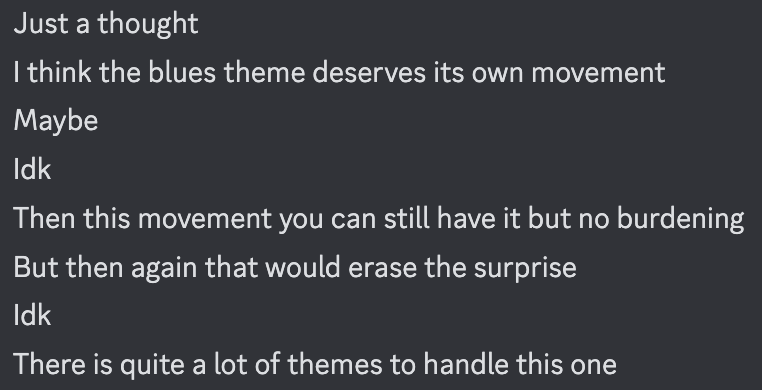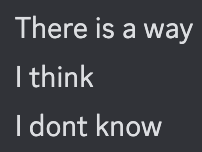All Activity
- Past hour
- Today
-
Thinking, "I should write a theme first and then a contrasting one," is exactly the sort of thinking about form that he is discussing. You sound like you are well on your way to thinking about the large scale issues with a piece, rather than just writing note by note. It sounds like he's talking about how beginning composers just sort of work from one note to the next without any rhyme or reason. There may be no theme at all, just a random succession of notes that they liked for five minutes straight. Everyone works one note to the next, but the more experience you have, the more you'll be thinking ahead about how to organize yourself in the choosing of those notes. Thinking, I have a fast section, so next I should have a slow one for contrast... that sort of thing. Or, I'm going to have range issues if I give this bit to that instrument without modulating. Do I want to modulate, or do I want to give it to a different instrument... And he wants to suggest some simpler exercises to get you started thinking about these sorts of things before you decide to write a whole symphony. Use fewer instruments. Write a short theme and see if you can turn it upside down. Practice writing a fugue. Also, Schoenberg is writing in a way that makes him sound like a big smarty pants so he can scare you into doing your homework, so don't be intimidated into a state of confusion, just do the exercises. (My best guess at what he was going for at any rate).
- 1 reply
-
- 2
-

-
Artdreamer77 started following Conceiving the entire form before beginning a composition
-
I recently bought Fundamentals of Musical Composition by Arnold Schoenberg and I am excited to be reading it as it is the first real reading I am doing on musical composition. In the first chapter he writes the following: "A composer does not, of course, add bit by bit, as a child does in building with wooden blocks. He conceives the entire composition as a spontaneous vision. Then he proceeds, like Michelangelo who chiselled his Moses out of the marble without sketches, complete in every detail, thus directly forming his material. "No beginner is capable of envisaging a composition in its entirety; hence he must proceed gradually, from the simpler to the more complex. Simplified practice forms, which do not always correspond to art forms, help a student acquire a sense of form and a knowledge of the essentials of construction. It will be useful to start by building musical blocks and connecting them intelligently." My question is how a composer can in their vision of the composition, imagine the entirety of the form before composing even a single motive. Sure, before beginning a composition, the composer feels the ineffable essence of what they wish to express in their composition, but the form is part of that too? I was surprised to read that a composer does not add bit by bit, since it seems natural to compose by writing a theme, and then a contrasting one. I have not, though, had much success doing so, so I guess I must begin small and internalize form as a begin composing small forms for practice. I may be misunderstanding something, but reading this seemed like a reality check that I was thinking of form wrong as a composer. Or maybe this "spontaneous vision" of the form is something only the greatest of the great composers can master. I don't know; I'm a beginner.
- 1 reply
-
- 1
-

-
Lo, the full, final sacrifice (Finzi) orchestration
develop331 replied to develop331's topic in Orchestral and Large Ensemble
@Alex Weidmann hello, I tried using cantamus but it didn't really go well, it genuinely sounds like a mixture between a dying cat and an air raid siren. Listen to it from 10:10 or so and the quality really goes down quite quickly 🙂 Thanks for the suggestion though, it was fun trying out. -
PeterthePapercomPoser started following String quartet #1 - 2nd movement and Aurora (Ancient Greece inspiration)
-
Lately, I've been thinking and imagining how Ancient Greece was reinterpreted in Impressionism. And well, all of that inspired me to write something. The dawn is that moment before sunrise when there is already light. For a brief explanation of what resources I use: Aurora
-
I really like how it turned out. Both the sounds you used (the organ in particular, or whatever it is) and the composition itself.
- 3 replies
-
- early music
- baroque
-
(and 7 more)
Tagged with:
-

Advice on stereo panning of the orchestra
AngelCityOutlaw replied to Alex Weidmann's topic in Composers' Headquarters
I've actually been thinking about this a lot lately. I was studying the film scores and other orchestral recordings of the '90s in particular and trying to figure out, aside from things like tape, what made them sound the way they do. In researching it, I found that in the way it was recorded, mostly owing to technology of the time, is that the stereo field actually has a strong center. I don't think one gets the best results by trying to pan the orchestra precisely to where they would sit in real life, because it creates an image that is just too wide for a stereo recording. Which is a 2 dimensional thing, unlike the 3D sound you would experience if you were actually seated in a hall. It's like bass. As you mentioned, the low strings being off center feels wrong on a recording. I usually use a mono summing plugin to put the basses right in the middle. That's not "realistic", but it's what works for a recording. What you can do, is pan the orchestra basically according to its seating, but then use a mono plugin to slightly reduce the overall stere field by around 15% or so. You can still tell that the instruments are panned, but they all have more of a center image than they do "out of the box".- 1 reply
-
- 1
-

-
Hey @Henry Ng Tsz Kiu! I just thought I'd have another go at some random impressions to your random sounding 3rd movement! LoL I feel like measures 8 - 10 should be more different sounding rhythmically from 11 - 12. Right now they sound really similar even though the rhythms are clearly supposed to be different, which I think is just a result of your lazy right hand! LoL The chord in measures 16 - 18 sound really muddy and thick in the bass range (which is very Beethovenian of you!). I am not a particular fan of that aspect of both yours and Beethoven's music though. I like the confused allusion you make at measure 20 to one of the other movements of this sonata (I don't remember which right now and I'm too lazy to check LoL). It does really sound strange and confused like the music momentarily doesn't know where it's going. I like how you invert the main Allegro theme in the bass in measure 29. Cool canonic imitation! I thought the transition at measure 38 could have been milked further for a longer amount of time to give a more complete sense of transition (especially since you had just finished a 12 bar phrase and keeping the number of bars even numbered in each phrase might have been more appropriate here). I like the transition to a Revolutionary Etude style of accompaniment in measure 39! But in your favorite key of C# minor instead of C minor as in Chopin's piece, which I think makes it a little bit more difficult to play. Nice Locrian inflection at bar 47 which also seems like an allusion to the Revolutionary Etude since Chopin kind of does the same thing with the harmony at a certain place. I like how you gradually foreshadow the Nihilistically Scherzando section in the crazy part (63 - 71). I totally neglected to realize and mention how the Scherzando is both a 12-bar blues and includes a melody from somewhere before interweaving in between the crazy dotted rhythms! The constant juxtapositions between quick Allegro Agitato phrases and slow Adagio question-like phrase derived from another movement are really musically interesting and dramatic! I don't really feel like the transition at measure 183 does a good job at preparing the listener for the beautiful sweet appassionato melody you expose in the next bar (which I know is another quote of a melody from one of the other movements but I don't know which LoL). Nice canonic alternation between the right and left hand playing the melody in the appassionato section. I know you consider bars 221 - 241 as the most impressive part of this movement, but I don't really like it that much personally. I know it must have been difficult to play and it's a great technical feat to be able to execute! But musically it just doesn't do it for me LoL. I like how the recapitulation creates another juxtaposition between the crazy 12-bar blues material and the Adagio allusion. Are the pentatonic scales the quote of your Sextet? I think it's note entirely out of place in this piece. Nice ending - it sounds quite conclusively finished after a monumental work. Bravo! Thanks for sharing!
-
Hi Maggie! Thx! The recording is far from perfect, it took me the 4th take to get this recording. The rent of the studio lasts only an hour so I took the last recording as the best one. I did get touched playing this recording, esp. after the final C sharp minor blow I can barely made those 3 digs of graves of that C sharp minor chords, due to desolation in myself as well as in the music. Thx! I like them too, esp. the crazy section since it's indeed a bit hard and technical to change btw styles. Yeah for me coherence is always the most crucial aspect in my own music. I have to make the movements in a multimovement work is indeed connected in a meaningful way temporally, otherwise they shouldn't be put together in the firt place. Through reappearence and variation the same theme and motive will have different narrative and emotional significance. Thx for your review! Henry
- Yesterday
-
stewartIM joined the community
-
This is a dreamy and delightful piece, which benefits greatly from the sound of the electric piano, Rhodes, or whatever.
-
Marc Deflin started following String quartet #1 - 2nd movement
-
Hi forum 🙂 Here's the second movement - adagio - of my first string quartet. It's a quite even piece, structured A B C A' D C. The A' is the first A theme replayed lower in a clear G Major tone, whereas the original A is more thought about as in a B minor b9+6 (written in a G Major key for commodity). The main theme of the first movement is hinted at on bar 28 (beginning of C theme) : That's all ; hope you'll enjoy 🙂 Best regards Marc
-
Fugue for small orchestra
Marc Deflin replied to Luis Hernández's topic in Orchestral and Large Ensemble
Nice and joyful work 🙂 -
Orchestral Overture in C-sharp minor.
Marc Deflin replied to Fugax Contrapunctus's topic in Orchestral and Large Ensemble
Great work @Fugax Contrapunctus, counterpoint master 🙂 You set a nice drama mood here not devoid of hope as I feel it. Would be a great opening - though rather short - for a larger, epic opus. Thanks 🙂 -
Trio Sonata in g minor for Alto Recorder, Violin and Continuo
Marc Deflin replied to Willibald's topic in Chamber Music
Hi @Willibald I enjoyed your work. It's pleasant to hear some - nice - music in this demanding style 🙂 I'm a fan of harpsichord, which you handle well here. Regards 🙂 Marc -
Fughetta in C minor for String Quartet.
Marc Deflin replied to Fugax Contrapunctus's topic in Chamber Music
Hi @Fugax Contrapunctus I loved this work ; this is both a cool technical exercise and a well written theme 🙂 Thanks for sharing -
How many takes do you need to get a recording of this length to your satisfaction? Bravo! I really enjoyed the transition at bar 63. (The "crazy" section). It works well as a bridge between the classical beginning and later jazz styles. I also particularly enjoyed the 130s (Allegro agitato) where you switched back in the other direction. And I heartily agree with Chopin's comment above about the value of structure and storytelling in music. To tackle such a lengthy project that becomes perhaps the most important concern. How can the same material be brought back and developed in a way that tells a story? You are further along on that journey than I am! Well done!
-
Thanks! But it actually does not have a form, early baroque sonatas does not have a form at all, it was more based in sections, and it was one single movement, but in those different sections there could be different time signatures, rhythms, modes, tempi... So its a very free style. And also we don't work with phrases, more like motifs, and the imitation and developing of those. About the reverse chord idea its already very much common in all the early baroque repertoire and also renaissance, the only thing about picardy thirds is that they are basically optional now days, but back in the renaissance and baroque it was basically obligatory, because the most common temperament in that time were Meantone temperaments, which favor pure major thirds and sixths. Because of that most of the cadences are indeed using it, but its not really obligatory, you can have an entire piece without any picardy third, and to standarts of that time period it would be completely fine. The reason i use them is because they were obviously more common than the normal minor chords and because they sound nicer to the ears, since the melodic line of the voice which creates the major third in the end is almost like sweetened, and its much easier to sing than the otherwise natural interval.
- 3 replies
-
- 1
-

-
- early music
- baroque
-
(and 7 more)
Tagged with:
- Last week
-
yeah it's really difficult and does take me a lot of time to practice. But it definitely worths it even though I still make some mistakes on the recording! Thx! I actually like the sudden attack idea of the 1st subject so I don't arrange a longer transition after the 2nd Subject! Haha yeah I feel like the 2nd mov is out of place in a good way, since it is there I try to find peace between two bombardous movements! And I do like its reappearence at the end here. Thx very much for listening and commenting! Henry
-
Lo, the full, final sacrifice (Finzi) orchestration
develop331 replied to develop331's topic in Orchestral and Large Ensemble
Thank you, I'll take a look at this to see what I can do. 😃 -
program notes: Act III: Betrayal Ross begins to sense something wrong—what should have been a simple meeting starts unraveling into a web of deception. Aldric secretly contacts Isolde, planting seeds of confusion. His new, manipulative theme emerges, cold and calculated. Isolde’s presence grows stronger, but so does Ross’s fear. Despite Ross’s efforts to intervene, Aldric’s control deepens. Tension builds as Aldric floods Isolde with messages, mocking Ross in the shadows. Ross spirals into paranoia, captured in the emotional haze of the Pool of Constant Fear. But clarity breaks through—Ross finds a way to act. He reaches out to Isolde himself. A confrontation follows. Aldric’s mask finally slips. His schemes are exposed. For more context visit this.
-
OK, thank you very much for your suggestion.
-
Hello @L.S Barros and welcome to the forum! Nice sonata! I assume (you can correct me if I'm wrong) that this is a sonata de camera? I love the constant exchange between major and minor mode that is so characteristic of music in this style, with all its Picardy 3rds (as I learned on your server). I do wonder how it would sound if you tried reversing the pattern - like, what if a phrase in a major mode ended on a minor chord? Or maybe you or some other Baroque-style composer already do this? I get the sense that this is a dance and is a piece that could easily be danced to in real life rather than just being a dance form that evolved out of an actual dance but is meant to be just an instrumental (which is why I'm guessing that this is a sonata de camera). Thanks for sharing and I hope you find this forum to be a good platform to share more of your works and participate by listening to other composers' works and possibly reviewing them! Kind regards,
- 3 replies
-
- 1
-

-
- early music
- baroque
-
(and 7 more)
Tagged with:


.thumb.png.8b5b433a341551e913a34392660bc95b.png)






